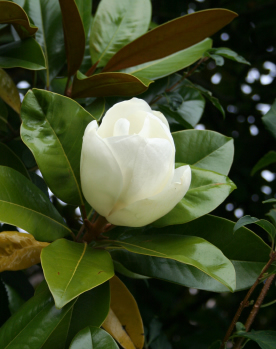Magnolia Magnolia Glauca

magnolia blossom
- Common Names
- Magnolia , Swamp sassafras, Sweet or White Bay
- Botanical Name
- Magnolia Glauca
- Syn. Magnolia Virginia
- Family
Medicinal Uses & Benefits of Magnolia
![]() How to Use|
Side Effects |
Plant & Garden|
How to Use|
Side Effects |
Plant & Garden|
- Parts Used: bark, leaves, flowers
How to Use: Magnolia
The beautiful magnolia has a long history of use in the traditional folklore of the South. The preparation of the bark was once official in the U.S. Ph. until the early part of the last century. The early American settlers learned the medicinal value of magnolia from the Indian people.
“The use of the fresh bark, cones, and seeds of this species, together with those of M. grandiflora, acuminata, tripetala, and macrophylla, was descended from the Native Americans, who employed a warm decoction of the bark and cones extensively against rheumatism, and a cold infusion as a antiperodic. The fresh bark has long been considered as a bitter, aromatic tonic, febrifuge, diaphoretic, antiperiodic and gentle laxative, in acute coryzas, bronchial catarrhs, chronic rheumatism, dyspepsia, remittent and intermittent fevers and typhoid states, being contraindicated if inflammation be present” Millspaugh, Charles F. "American Medicinal Plants" (1882) 44[12-2]
Preparation Methods & Dosage :A decoction of the bark is the most common preparation, the flowers are sometimes used for their scent in cosmetics. The leaves can also be used in cooking and in teas.
Plant Description
- Plant Class: Shrub - Evergreen southward, Decudious northward. This beautiful swamp shrub usually grows to a height of 4 to 20 feet.
- Flowers/Fruit/Seeds:Globuar white flowers, very fragrant
- Parts used: Bark Smooth, whitish
- Leaves: Scattered, oblong, oval, or ovate-lanceolate, thick, shining green above and blueish white below.
- Flowering Season:May (southward) to June and August
- Distribution:The Sweet magnolia is indigenous to North America from Cape Ann and Long Island southward. At first it keeps to the seaboard but gradually extends inland the further south it is found. It grows in swamps
Regional Traditions :North America *










